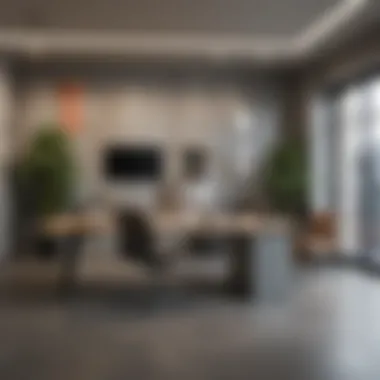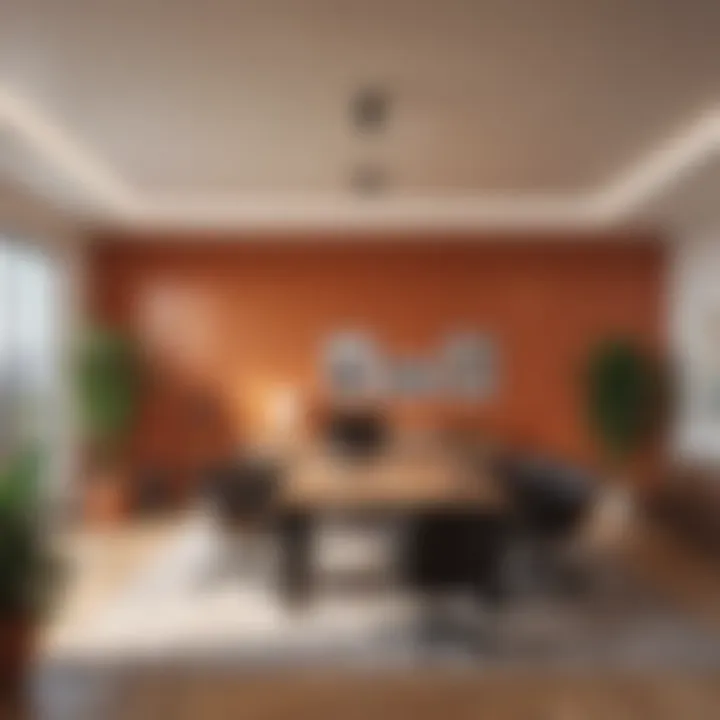Choosing the Right Paint Colors for Your Office


Intro
Creating the right atmosphere in an office can significantly influence both productivity and employee satisfaction. The choice of paint colors plays a pivotal role in establishing this environment. Each color evokes specific emotions and responses, which can either enhance or hinder the work experience.
In this article, we will delve into color psychology and explore how various hues can impact mood, creativity, and overall efficiency. Additionally, we will provide strategies for selecting colors that align with the nature of the work being done, the layout of the office space, and the preferences of employees. Finally, trends in office design and practical applications will be examined to provide a well-rounded guide for enhancing the office through color.
Understanding the Role of Colors in Office Design
The choice of paint colors in an office is far from a trivial matter. It can significantly affect not just aesthetics but also functionality and morale within a workspace. Colors possess inherent characteristics that evoke emotions and influence behaviors. Understanding their role becomes essential in creating a conducive environment for work.
The implications of color choices extend to various domains, including employee productivity, collaboration, and overall job satisfaction. Selecting the right colors can lead to better concentration, enhanced creativity, and even improved interpersonal relationships among coworkers. For instance, a well-chosen color palette can act as a psychological tool to inspire employees, resulting in a positive work atmosphere.
The Psychological Impact of Color
Colors affect human psychology in profound ways. Different hues trigger distinct emotional responses. For example, warm colors like red and orange can evoke feelings of excitement and energy. They may be suitable for spaces where motivation is key but can also result in overstimulation. In contrast, cooler colors such as blue and green tend to promote calmness and focus. They are often a better choice for environments that require sustained attention and mental clarity.
Overall, understanding these psychological elements helps in selecting colors that align with the desired employee response. The implications of color psychology can extend beyond mere aesthetics; it can shape workplace culture and employee engagement.
Color and Productivity
The link between color and productivity cannot be overstated. Studies have shown that distinct colors impact focus and efficiency in different ways. For instance, a well-lit office painted in light blues or greens can enhance concentration levels. These colors help in reducing stress, which is essential for maintaining high productivity.
On the other hand, brighter colors like yellow can stimulate creativity and innovation. They can be beneficial in spaces where brainstorming sessions are frequent. However, balance is necessary; too much bright color can be distracting. Understanding the kind of work being done in the office can help in choosing colors that foster the desired output.
Color and Employee Well-being
The well-being of employees is critical for any organization. Choosing the right colors is a factor that plays an important role in that regard. Colors can create a supportive environment that enhances comfort and reduces anxiety. For example, soft neutrals can make a space feel more inviting and warm, while harsh and stark colors may create feelings of discomfort or stress.
According to numerous studies, spaces that employ colors that promote well-being see lower turnover rates and higher levels of employee satisfaction. Hence, the consideration of employee well-being should be integral to the decision-making process in selecting office colors.
"Colors in the workspace can serve as tools to create engagement and enhance the overall work experience."
Color Psychology Basics
Understanding color psychology is essential when selecting paint colors for an office environment. Colors elicit emotions and can influence behavior. This section delves into warm, cool, and neutral colors, providing insights into their effects on spaces where individuals work tirelessly.
Warm Colors and Their Effects
Warm colors include reds, oranges, and yellows. These colors often evoke feelings of warmth and excitement. They can increase energy levels and stimulate conversation among employees. However, they can also become overwhelming and lead to stress if overused. When incorporating warm colors in an office, consider using them as accents rather than the primary hue.
- Red: This color draws attention. It can stimulate passion and intensity but may lead to feelings of aggression if used excessively.
- Orange: Known for its cheerful tone, orange combines the energy of red with the happiness of yellow. It can create a fun atmosphere but should be used moderately.
- Yellow: Often associated with optimism and creativity, yellow can uplift moods. Too much yellow, however, might provoke feelings of anxiety.
Cool Colors and Their Effects
Cool colors like blues, greens, and purples tend to have a calming effect. They are associated with tranquility and stability. Such shades can foster concentration and a sense of relaxation, making them suitable for work environments that demand focus and clarity. Here are specifics on the cool color palette:
- Blue: This color is known for its ability to reduce stress and encourage productivity. Light blue can create a serene environment, while dark blue adds professionalism.
- Green: Symbolizing harmony and renewal, green can improve mood and reduce fatigue. It is good for spaces where employees spend long hours.
- Purple: Often associated with creativity, purple can inspire innovative thinking. It is best used in moderation, as darker shades can feel heavy.
Neutral Colors in a Professional Setting
Neutral colors such as whites, grays, and beiges are timeless choices for office spaces. They provide a clean backdrop that allows other elements to shine while fostering a sense of professionalism. Neutrals can be versatile and blend well with most color combinations.
- White: Often seen as pure and clean, white can make spaces appear larger. It is important to balance it with other colors to prevent a sterile feel.
- Gray: A popular choice for modern offices, gray adds sophistication without overwhelming the senses. It can be paired easily with both warm and cool accents.
- Beige: Providing warmth, beige creates an inviting atmosphere. It can serve as a warm background while remaining subtle enough not to distract.
"Colors are the smiles of nature." - Leigh Hunt
In summary, understanding color psychology allows for informed choices that align with the desired atmosphere and functionality of the office. Choosing the right colors can enhance creativity, productivity, and overall employee satisfaction.
Selecting Colors Based on Office Type


Choosing the right paint colors for an office requires a careful examination of the type of workspace. Each type has a distinct character and purpose, which can dramatically influence the effectiveness of color choices. For example, corporate offices need to convey professionalism, while creative workspaces benefit from stimulating colors. By aligning color selections with the specific office type, businesses can enhance mood, productivity, and overall employee satisfaction. Below, we explore how to select colors effectively for three distinct office types—corporate offices, creative workspaces, and home offices.
Corporate Offices
In corporate offices, the choice of color should reflect a balance between professionalism and approachability. Neutral tones like gray, beige, or soft blues are often effective in fostering a calm and focused environment. These colors can create a sense of sophistication, supporting the image of stability and efficiency.
- Benefits of Neutral Colors: Neutral palettes allow for flexibility in office furniture and decor. They form a clean backdrop that ensures distracting elements are minimized. Additionally, corporate branding can be integrated through carefully selected accent colors or artwork.
- Considerations: It is essential to evaluate how the chosen colors affect the mood and productivity of employees. A cold feeling may arise from too much gray; thus, adding warm accents can enhance comfort. Furthermore, ensuring ample natural light can help prevent the space from feeling too clinical.
Creative Workspaces
Creative workspaces thrive on inspiration and flexibility. Here, brighter colors can stimulate imagination and collaboration. Shades like orange, green, and even vibrant purple can evoke energy and creativity.
- Enhancing Collaboration: Using an assortment of colors can delineate different areas within the same workspace. For example, more vibrant colors may encourage brainstorming zones, while calmer shades can support quiet work areas.
- Application of Color Psychology: Research supports that colors like yellow can boost creativity—making it a great option for walls or accents in innovative spaces. The key is to balance energizing colors with areas for retreat, ensuring that employees are not overwhelmed by constant stimulation.
Home Offices
Home offices should reflect the personality of the individual while supporting productivity. This space is often a blend of personal and professional demands, necessitating a thoughtful approach to color. Soft blues and greens can create a serene atmosphere conducive to focus, whereas other spaces might benefit from more invigorating shades.
- Personalization: It is crucial to choose a color scheme that resonates personally while still being functional. Adding personal touches further enhances the space's usability and comfort.
- Mixing Functional with Aesthetic: Opt for colors that not only inspire but also reduce stress. Muted tones help maintain an environment that promotes concentration. Consideration of the room's lighting—natural and artificial—can influence how colors appear, thus affecting the work experience.
Trends in Office Paint Colors
The selection of paint colors in the office is not just about aesthetics. Understanding trends in office paint colors has powerful implications for design and functionality. It reflects an organization’s identity, values, and culture. Staying updated on color trends can provide businesses a competitive edge by creating a desired work atmosphere and enhancing employee morale.
Current Color Trends
In recent years, numerous color trends have surfaced in office design. Neutral tones, such as whites, grays, and beiges, continue to dominate but are often combined with brighter accent colors. Shades like navy blue and forest green are increasingly popular as they evoke sophistication and calmness.
- Warm Neutrals: Incorporating shades of beige, cream, or taupe can give warmth to a space.
- Bold Accent Colors: Vivid colors like cobalt blue or citrus yellow can be used to create focal points.
- Organic Colors: Earth-inspired tones like greens and browns are gaining popularity for their soothing effects.
These choices reflect not just personal preference but also adapt to emerging workplace needs, promoting collaborative and individual work environments.
Sustainable Color Options
As awareness of environmental issues increases, sustainable paint options have become more appealing. Low-VOC and eco-friendly paints are designed to minimize the ecological footprint. They also improve indoor air quality, which is vital for employee health.
When considering sustainable options, look for brands that emphasize:
- Natural Pigments: These have minimal chemical additives.
- Recyclable Materials: Some manufacturers focus on creating easily recyclable paint containers.
- Certifications: Look for labels like GREENGUARD or EcoLogo as indicators of environmentally friendly products.
Choosing these sustainable options can convey an organization’s commitment to social responsibility. It's more than a trend; it's an essential consideration for modern office design.
Tech-Inspired Colors
The digital age is significantly influencing color choices in offices. Tech-inspired colors reflect innovation and forward-thinking. Colors that resonate with technology often feature muted shades combined with pops of bright colors.
- Metallic Accents: Incorporating silver or chrome finishes can evoke a feeling of modernity.
- Cool Tones: Shades like teal or digital blues bring a fresh touch and stimulate creativity.
- Neon Highlights: For those who want to make a bold statement, neon colors promote energy and are often found in creative workspaces.
This tech influence not only aligns with modern aesthetics but also can inspire employees and encourage a vibrant work atmosphere.
"Understanding and integrating color trends can strengthen an organization’s identity while creating an inviting workplace that encourages productivity."
By being attuned with these trends, organizations can thoughtfully select colors that resonate with their workforce and reflect their brand identity. The right paint colors can ultimately transform an office environment, making it more engaging and enjoyable for everyone.
Practical Considerations When Choosing Colors
When selecting paint colors for an office, it is crucial to consider practical aspects that can profoundly influence the overall efficacy of the workspace. Understanding these factors ensures that the coloring process aligns with the functional requirements of the office while also catering to the aesthetic preferences of its users. Each decision regarding color should weigh not only personal preference but also the practical implications that colors create in a work environment.
Space Size and Light
The size of the office space has a significant impact on how colors appear and their effect on the atmosphere. In small offices, lighter colors such as soft whites or pastels can create an illusion of a larger space, making it feel more open and airy. Conversely, dark hues can make a room appear cozier but may also make it feel cramped. Understanding the natural light available is equally important. Bright, sunlit spaces can accommodate bolder shades without overwhelming the senses, while well-lit spaces may benefit from softer tones to avoid glare. Inadequate lighting exposes colors differently, making it necessary to test paint samples in situ—this means observing how they look at various times of the day.


Furniture and Decor Compatibility
Choosing colors should also consider the available furniture and decor in the office. The colors on the walls and those of furniture should complement each other rather than clash. It is advisable to analyze existing items' colors and styles before finalizing paint choices. For instance, if the office has dark wooden furniture, lighter wall colors can create a pleasing contrast. On the other hand, vibrant furniture might look best against more muted walls. Beyond color, texture must also be considered. A smooth finish may not pair well with overwhelmingly textured decor. Achieving a balance between paint and furnishings creates a coherent design language throughout the space.
Employee Input and Preferences
Lastly, gathering employee input on color choices can foster a sense of inclusion and personalization within the workplace. Employees spend considerable time in their work environment; thus, their preferences can greatly influence satisfaction and productivity. Organizing a brief survey or discussion can reveal favored color schemes and assist in making decisions that feel more democratic. While professional insights on color psychology are valuable, employee preferences add a vital layer of relevance, ensuring that selections resonate on an individual level. Additionally, colors that are pleasing to employees can impact morale and engagement positively.
"Color can play a key role in shaping moods and perceptions in an office. It is more than aesthetics; it serves practical functions too."
In summary, practical considerations when choosing colors involve assessing the size and light of the space, ensuring compatibility with existing furniture and decor, and including employee preferences to enhance the overall experience. This holistic approach not only beautifies the office but also creates a harmonious and functional workspace.
Color Combinations for Office Spaces
Color combinations play a crucial role in office design. They influence mood, productivity, and the overall atmosphere. Selecting the right color scheme can make a significant difference in how employees perceive their work environment. Proper combinations enhance aesthetics and can also promote teamwork, focus, and creativity.
Understanding color combinations can help in creating harmonious spaces that meet functional and emotional needs. Different color schemes can respond well to various types of work activities. An effective color strategy leverages the psychological aspects of hues to create a balanced workplace.
Monochromatic Schemes
Monochromatic schemes involve using different shades and tints of a single color. This approach can create a sense of cohesion and stability. It simplifies the design process and ensures consistency throughout the space. By varying the lightness or darkness of one color, it is possible to create depth and interest without overwhelming the senses.
Benefits of monochromatic coloring include:
- Creates a sophisticated and clean look.
- Easy to match with existing furniture and decor.
- Reduces visual clutter, promoting focus.
Consider using tones of blue or green, which are calming and can enhance concentration. In contrast, warmer tones may reduce the potential sterility often associated with monochromatic designs, infusing energy into the space without losing harmony.
Complementary Colors
Complementary colors are those located opposite each other on the color wheel. This technique creates striking contrasts and draws attention. While bold combinations can energize a workspace, it’s critical to use these sparingly to avoid visual fatigue.
Some aspects to consider when implementing complementary colors include:
- When applied thoughtfully, they can energize and invigorate the space.
- Ideal for meeting rooms where stimulation is beneficial.
- Encourage motivation and engagement among employees.
A pair like blue and orange can inject vibrancy into creative areas. However, use larger amounts of neutral tones to balance the intensity while maintaining a dynamic environment.
Accent Colors
Accent colors provide the finishing touches to a design scheme. They are used sparingly to highlight features or create focal points. The strategic use of accent colors can add personality and warmth to an office.
Key points about accent colors:
- They draw attention to specific areas, such as conference rooms or relaxation zones.
- Provide opportunities to showcase a brand’s colors subtly.
- Can be changed easily without undergoing a full redesign.
For example, using a bright yellow for a few decorative items can lift the spirits in an otherwise neutral area. The careful application of accent colors can ensure that they do not overpower the primary color scheme but rather enhance it.
Overall, effective color combinations contribute to an effective and inviting office space. By understanding how to mix and match these colors, individuals can create environments that not only look beautiful but also support the health and productivity of employees.
Implementing Color in the Office
The process of implementing color in the office is a crucial step in creating an effective work environment. It goes beyond mere aesthetics. The right paint colors can profoundly affect employee morale, creativity, and overall productivity. This section discusses the essential considerations when integrating color into office spaces, focusing on the finish, choosing between DIY or professional help, and maintaining painted areas.
Choosing the Right Finish
The finish of the paint plays an important role in the overall perception of the color and its impact. Different finishes can create varying effects on light reflection and durability. For example, matte finishes absorb light and create a soft look, which may evoke a calming atmosphere. However, they are less resistant to stains and wear. On the other hand, semi-gloss and gloss finishes reflect more light, which can make rooms appear larger and brighter. These finishes are often easier to clean, making them suitable for high-traffic areas.
When selecting the finish, consider the type of activities that will take place in the space. If the area is prone to messes, a more durable finish could be wise. Conversely, if the goal is to foster a tranquil environment for focused work, a matte finish might be the better choice.


DIY vs. Professional Help
Deciding whether to undertake a do-it-yourself project or hire professionals is another pivotal choice. DIY painting can be an enjoyable experience. It allows for personal expression and can be cost-effective. However, it may not always yield the best results if the skill level is lacking or the proper tools are not available. For instance, uneven brush strokes or misapplied paint could detract from the overall aesthetic.
In contrast, hiring professionals guarantees a level of expertise and high-quality finishes. Professionals possess the knowledge of color application techniques and can efficiently handle the logistics of large projects. They can also provide valuable input on color choices tailored to specific office needs. Therefore, when evaluating whether to go DIY or professional, it is essential to weigh the desired outcome against budget constraints and time availability.
Maintaining Painted Spaces
Once the colors are chosen and applied, maintenance becomes vital to preserving the intended look and feel. Regular upkeep helps prolong the life of the paint, keeping the office environment engaging and inviting.
Here are some tips for maintaining painted spaces:
- Regular Cleaning: Dust and dirt can accumulate on walls over time. Use a soft cloth and mild detergent to clean surfaces without damaging the finish.
- Touch-Ups: Keep extra paint for touch-ups. Minor scuffs or scratches can be promptly addressed to maintain a polished appearance.
- Monitor for Damage: Pay attention to signs of wear or moisture problems. Address these issues quickly to prevent more significant and costly damage.
Implementing color in the office is not only about aesthetics. It touches on critical factors such as employee well-being and productivity. Taking careful steps in choosing finishes, deciding between DIY and professional help, and ensuring ongoing maintenance can create a thriving work environment.
"Color, in its essence, is an emotional response. It can uplift, calm, or inspire. The proper use of color can transform not just a space but the way people experience their work life."
The thoughtful integration of color will enhance any workspace. As you approach this process, remain mindful of the implications of your choices.
Case Studies in Office Color Design
Case studies in office color design serve as a practical tool to understand how specific choices in paint colors influence office environments. These examples reveal the transformative potential of color, providing concrete evidence of how well-thought-out decisions can lead to enhanced productivity and improved employee satisfaction. In this section, we will analyze a few notable case studies that illustrate the impact of color in various office settings. By examining these real-world applications, businesses and individuals can glean valuable insights into best practices for their own spaces.
Successful Corporate Redesigns
In the corporate world, an effective redesign can mean the difference between a stale work environment and one that inspires creativity and collaboration. Many companies have recognized the need to create visually appealing and motivating spaces. For instance, a large tech firm opted for a complete overhaul of their office space, incorporating a palette of fresh greens and blues. The result was a rejuvenated atmosphere that prioritized well-being and engagement.
According to a case study published in The Journal of Environmental Psychology,
"Color not only affects our emotions but can also influence our decision-making and effectiveness at work." This transformation led to a measurable increase in employee productivity and overall morale. By employing colors that resonate with their brand's ethos, the company effectively used hues to reinforce their identity and foster a sense of belonging.
Innovative Home Office Transformations
As remote work becomes the norm, many individuals are rethinking their home offices. The challenge is to create a space that feels professional while maintaining comfort. One homeowner redesigned their office by painting the walls a soft pastel yellow, paired with darker navy accents. This combination not only provided a calming effect but also added a touch of vibrancy.
Further research indicates that incorporating natural light with lighter colors can enhance focus. The home office layout included a large window that allowed sunshine to pour in, amplifying the effects of the yellow hue. This case illustrates that personal choice in design can lead to significant improvements in work efficiency and user satisfaction.
Color Impact on Employee Satisfaction
The relationship between color and employee satisfaction cannot be overstated. A study involving a major financial institution demonstrated this connection effectively. After renovating their offices with muted tones of blue and beige, surveys indicated a notable increase in employee morale and comfort levels.
The strategic use of color not only improved aesthetics but also impacted how employees felt about their workplace. This highlights the importance of considering employee feedback when making design decisions. Studies often show that employees feel more valued when their preferences are taken into account during a redesign process.
In conclusions, case studies in office color design provide compelling evidence of the role colors play in shaping environments. By learning from successful examples of corporate redesigns and innovative home office transformations, stakeholders can make informed decisions that enrich their workspaces. Whether focusing on employee satisfaction or exterior branding, color remains an essential aspect of office design.
Final Thoughts on Office Paint Colors
Evaluating Your Color Choices
When evaluating your color choices, several factors must be taken into consideration. Start with the overall theme of the office. Do you want a modern look or a more traditional feel? Different colors communicate different messages.
Besides aesthetics, it is crucial to assess lighting conditions in your office space. Natural sunlight can alter how a color appears on the walls. For instance, a bold blue might look calming in a sunlit room but could feel overwhelming in a dimly lit area. Therefore, testing paint samples in various lighting situations will yield better results.
Another vital aspect is to consider the preferences of employees. Engaging staff in discussions about color options can foster a sense of ownership and satisfaction. When employees feel included in the decision-making process, it can lead to increased morale and motivation across the office.
Creating a Lasting Impression
Creating a lasting impression with paint colors means that every detail counts. The first thing clients or visitors notice is the environment. A well-thought-out color scheme reflects professionalism and a commitment to quality.
- Consistency with Brand Colors: Consider how paint colors align with your brand’s identity. This coherence can cement your brand image in the minds of clients and partners.
- Use of Accent Colors: Employing accent colors thoughtfully can lead to visually striking outcomes. They can highlight important areas or features within an office, drawing attention where it is most needed.
A well-executed color strategy can direct the flow of energy in a space. Soft, light colors can create an open and inviting atmosphere, while darker tones might add sophistication but could also feel restrictive.
A transformative office environment reinforces the company's values and enhances employee performance.
Ultimately, the goal is to find paint colors that encourage productivity, increase well-being, and reflect the essence of your organization. The thoughtful selection of colors can have a profound impact on both daily operations and long-term impressions, making the office an ideal place to work and collaborate.



